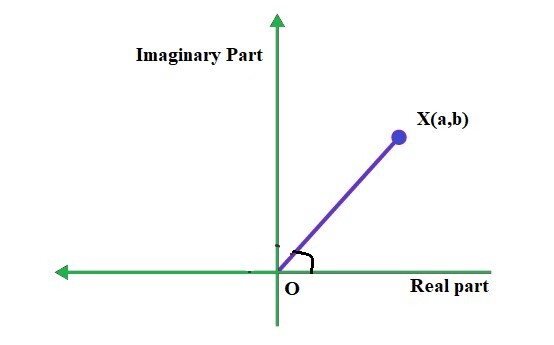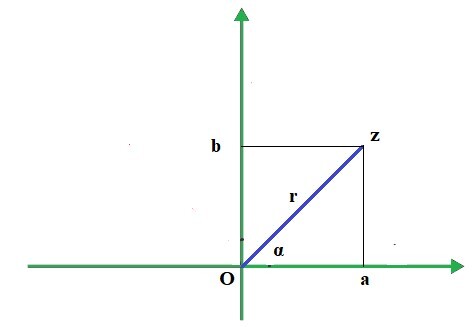
 Data Structure
Data Structure Networking
Networking RDBMS
RDBMS Operating System
Operating System Java
Java MS Excel
MS Excel iOS
iOS HTML
HTML CSS
CSS Android
Android Python
Python C Programming
C Programming C++
C++ C#
C# MongoDB
MongoDB MySQL
MySQL Javascript
Javascript PHP
PHP
- Selected Reading
- UPSC IAS Exams Notes
- Developer's Best Practices
- Questions and Answers
- Effective Resume Writing
- HR Interview Questions
- Computer Glossary
- Who is Who
Argument of Complex Numbers
Introduction
Argument of complex number can be described as the angle made by the line formed by the complex number, with the positive x-axis of the argand plane. Argument of complex numbers describes the relationship between the imaginary and real part of the complex number. In this tutorial, we will understand complex numbers, polar form of complex numbers, argument of complex numbers, and some examples based on complex numbers.
Complex Numbers
Complex numbers are elements of the number system that consist of real numbers along with imaginary unit, i.e. i. which satisfies the argument; i2=-1. When a complex number is drawn in the argand plane, the real and imaginary part of the complex number is marked along the x- and y- axis, respectively. Point X(a, b) in the argand plane can represent the line Z = a + ib, and the line OX makes an angle with the positive x-axis. The figure below shows the given complex number Z = a + ib represented on a complex plane. This plane is used to represent the geometric form of a complex number. The plane shows similarity with the cartesian plane with X-axis representing the real part and Y-axis representing the imaginary part.

For a complex number Z = a + ib, the argument of the complex number is the angle measure, which is equal to the inverse of the trigonometric tan function of the imaginary part, divided by the real part of the complex number.
$$\mathrm{Argument\: of\: Complex\: Number = ? = Tan^{-1} (b/a)}$$
Polar Form
Polar form of the complex number can be expressed as A = r(Cos? + i Sin?). Where angle ? and r are the argument of the complex number and modulus of the complex number respectively. It is one of the key ways of expressing the polar form of a complex number. The coordinates of polar form of the complex numbers can be expressed as (rCos?, rSin?).

The figure above shows a complex number "z" with coordinates (a,b) represented on an argand plane. Angle ? is the angle that the line makes with the positive x-axis.
Argument of a Complex Number
A complex number in an argand plane can be defined by its two important characteristics: argument and modulus of the complex number. The distance of the coordinates of the complex number from the origin can be calculated by calculating the modulus of the complex number. Whereas, the angle between the line formed by the complex number and the positive x-axis form the argument of the complex number.
arg Z represents the argument of complex number Z =x + iy. For a complex number Z = x + iy represented by coordinates Z(x, y) and the origin of the line by O(0, 0), the angle subtended anticlockwise by the line OZ with the positive x-axis is known as the argument of the complex number. The angle thus formed by the complex number Z = x + iy is the inverse of the tan function of the fraction formed by the imaginary and real part.
$$\mathrm{Argument\: of\: Complex\: Number =? = Tan^{-1} (y/x)}$$
Solved Examples
1)Find the polar form of following complex numbers.
3 + 3?3i
1+2i.
9+9i
Answer:
a) Let Z=3 + 3?3i.
From the formula we know that the real part of the equation , x = 3 and the imaginary part, y = 3?3
We know that the argument of a complex number can be calculated by
$$\mathrm{arg (z) = tan^{-1} (y/x)}$$
$$\mathrm{arg (z) = tan^{-1} (3\sqrt{3}/3)}$$
$$\mathrm{arg (z) = tan^{-1} (\sqrt{3})}$$
$$\mathrm{arg (z) = (?/3)}$$
Therefore, the argument of the complex number is ?/3 radian.
b) Let Z=?3+i
From the formula we know that the real part of the equation , x = ?3 and the imaginary part, y =1
We know that the argument of a complex number can be calculated by
$$\mathrm{arg (z) = tan^{-1} (y/x)}$$
$$\mathrm{arg (z) = tan^{-1} (1/\sqrt{3})}$$
$$\mathrm{arg (z) = (?/6)}$$
Therefore, the argument of the complex number is ?/6 radian.
c) 9+9i
From the formula we know that the real part of the equation , x = 9 and the imaginary part, y =9
We know that the argument of a complex number can be calculated by
$$\mathrm{arg (z) = tan^{-1} (y/x)}$$
$$\mathrm{arg (z) = tan^{-1} (9/9)}$$
$$\mathrm{arg (z) = tan^{-1} (1)}$$
$$\mathrm{arg (z) = (?/4)}$$
Therefore, the argument of the complex number is ?/4 radian.
2) Find the modulus and argument for the following complex numbers.
3-4i
-5i
-4
Solution:
As we know that polar form of complex numbers can be expressed as
$$\mathrm{A = r(Cos? + iSin?)}$$
Where r=|Z| and ?=arg(Z)
a)
$$\mathrm{|Z|=\sqrt{3^2+(-4)^2}}$$
$$\mathrm{|Z|=\sqrt{25}}$$
$$\mathrm{|Z|=5}$$
We know that r=|Z|=5
$$\mathrm{?=arg(Z)}$$
$$\mathrm{arg (z) =tan^{-1} (-4/3)}$$
Therefore the polar form of the complex number can be written as
$$\mathrm{A=5 Cos (Tan^{-1} (-4/3))+i Sin(Tan^{-1} (-4/3))}$$
b) $\mathrm{|Z|=\sqrt{0^2+(-5)^2}}$
$$\mathrm{|Z|=\sqrt{25}}$$
$$\mathrm{|Z|=5}$$
We know that r=|Z|=5
$$\mathrm{?=arg(Z)}$$
$$\mathrm{arg (z) = tan^{-1} (-5/0)}$$
$$\mathrm{arg (z) = -tan^{-1} \frac{?}{2}}$$
$$\mathrm{arg (z) = -\frac{?}{2}}$$
Therefore the polar form of the complex number can be written as
$$\mathrm{A=5 Cos (-\frac{?}{2})+i Sin(-\frac{?}{2})}$$
c) $\mathrm{ |Z|=\sqrt{4^2+(0)^2}}$
$$\mathrm{|Z|=\sqrt{16}}$$
$$\mathrm{|Z|=4}$$
We know that r=|Z|=4
$$\mathrm{?=arg(Z)}$$
$$\mathrm{arg (z) = tan^{-1} (0/4)}$$
$$\mathrm{arg (z) = tan^{-1} ?}$$
$$\mathrm{arg (z) =?}$$
Therefore the polar form of the complex number can be written as
$$\mathrm{A=4 Cos (?)+i Sin(?)}$$
Conclusion
Argument of complex number can be described as the angle made by the line formed by the complex number, with the positive x-axis of the argand plane. Complex numbers are elements of the number system that consist of real numbers along with imaginary unit, i.e. i. which satisfies the argument; i2=-1. Polar form of the complex number can be expressed as A = r(Cos? + i Sin?). The distance of the coordinates of the complex number from the origin can be calculated by calculating the modulus of the complex number.
| Expression | Meaning |
|---|---|
| Z=a+ib | (a,b) represents the coordinates on an argand plane. |
| A = r(Cos? + i Sin?) | Represents the polar form of the complex number. |
| r=|Z| | Represents the modulus of the complex number. |
| ?=arg(Z) | Represents the argument of the complex number. |
FAQs
1. What is the common range for the argument of complex number?
The common range for the argument of complex number is (-?,?)
2. For two complex numbers, what is the value of arg(Z1/Z2)?
According to the properties of argument of complex numbers arg(Z1/Z2)=arg(Z1)-arg(Z2)
3. For two complex numbers, what is the value of arg(Z1ÃZ2)?
According to the properties of argument of complex numbers arg(Z1ÃZ2)=arg(Z1)+arg(Z2)
4. What is "i" in the complex number form Z=a+ib?
"i" is called iota. Iota represents the square root of -1, i.e., ?(-1)
5. What is an argand diagram?
Argand diagrams are used to represent the complex numbers with the horizontal axis representing the real part and the vertical axis represents the imaginary part.

